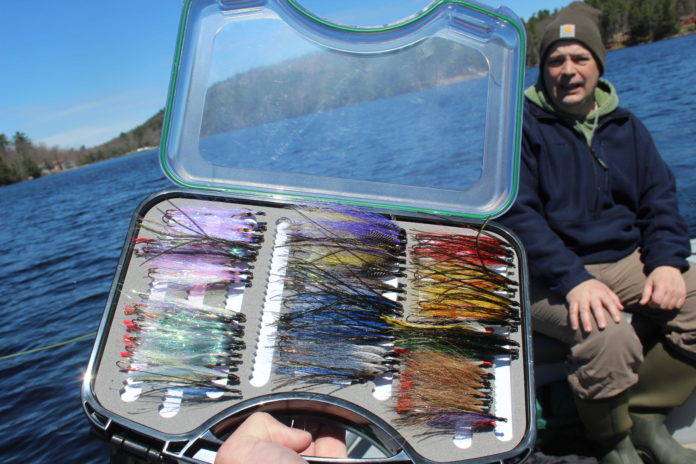This story was originally published in December 2019.
Fly tiers will spend the coming months stocking up on flies that they’ll use all summer long. Even those fly fishers who don’t tie their own will also spend a fair amount of time planning adventures for the coming months.
As we move toward another Maine winter, I sat down with Don Corey, the proprietor of the Annika Rod and Fly Learning Center in Brewer, along with veteran tier Ernie MacDonald, to ask for some fly tying and fishing “commandments” that could pay off for tiers and anglers.
And as always, they were eager to help their fellow fly fishers. Here are four suggestions that you’d do well to heed — a pair of tying tips, and a pair that deal more with fishing.
Keep ‘em lean
When you sit down at a tying vise and you’re surrounded by various piles of feathers and fluff, the temptation to create a puffy, bulky fly can be overwhelming.
Corey advises against that.
“You talk to guides and people who do a lot of fishing, especially people who use trolling streamers, and ‘thin to win’ is the key,” he said.
And his reasoning makes good sense: Streamer flies are often designed to resemble baitfish like smelts.
“You don’t usually see a fat smelt,” Corey said. “You see fat fishermen, but not a fat smelt.”
In fly tying classes instructors will often caution beginners, telling them that tying a sparse fly is better than tying a more robust version. The message: Use less of a material than you think you need, rather than more.
Don’t just tie one or two
When you begin tying a pattern during a session at the vise, you may be tempted to tie one or two flies, then move onto a different pattern. Boredom can strike. Variety is the spice of life. Right?
Wrong.
Corey said it’s important to push through that boredom and build up a good supply of a particular fly before tying a different one.
“A lot of times people will tie two of one pattern and then two of a different pattern that they’ve learned. You really need to sit down and tie a half dozen so you get some consistency,” Corey said.
A half dozen is good. A dozen is even better, he said.
There are a few reasons for that. Consistency, as he pointed out, is a good goal. But if you think of your vise as a fly tying factory, tying more of one fly at one sitting increases your efficiency, too.
“Probably a third of the time [you spend] tying is getting the materials ready and putting the materials away,” Corey said. “So if you get the materials out, tie [at least] a half dozen.”
The other benefit to tying more: You’ll get better at the techniques you’re using as you repeat them.
“By the time you get to fly number six or nine or 12, if you compare those to fly number 1, you’re probably going to see a pretty big difference,” Corey said.
Those first few won’t be great, but they can still serve a purpose.
“If you tie six or eight, the first couple are probably not going to be good. They’ll be of inferior quality,” Corey said. “Those are for giving. You give those to your friends. Then, 4, 5 and 6 are your flies.”

Think outside the box
Now, let’s talk about using those flies. Corey said that many fly fishers have certain expectations of what a given fly is supposed to look like, and when they stop by his shop to find one, they’re not willing to be very experimental.
“People tie flies for the fishermen, and not for the fish,” Corey said. “From a retail standpoint, if I don’t have a typical Hornberg and a typical gray ghost and a typical woolly bugger for sale, a lot of times people will pass right over it, [saying], ‘It doesn’t look like a Hornberg.’”
Even if a fly shop owner vouches for the odd-looking fly and tells the customer that anglers are having luck with the variation of a classic pattern, many will refuse to give it a try.
Sometimes, that reluctance to change can cost an angler a splendid day on the water with a new, super-productive fly.
And that’s just the way it goes.
“The traditional guy will say, ‘I hear what you’re saying, but I want a real Hornberg,’” Corey said. “We have our preconceived notions of what the fly looks like.”

Trust the fly
Here’s a news flash that shouldn’t surprise anyone: If you don’t fish a certain fly, you’ll never catch a fish with it.
Sounds simple, right? Maybe not.
“People always ask me, ‘What’s the best fly?’” MacDonald said. “I tell them, ‘The best fly is the fly you believe in.’ If you have a fly that you don’t believe will catch fish, you won’t catch fish with it because you’ll throw it out once or twice and bring it in. You won’t fish it.”
Corey agrees.
“Fishing’s about 75 percent confidence,” Corey said. “If you’re confident in a fly, you’re going to fish it longer and harder and give it every opportunity to catch fish.”
And it’s important to have confidence in a few flies, because most fly fishers end up collecting a dizzying number of them. Many will remain in fly boxes for months. Or years. Or forever.
“You know, people have 15 or 20 times the number of flies that they’re ever going to use,” Corey said.
More articles from the BDN
Credit: Source link































